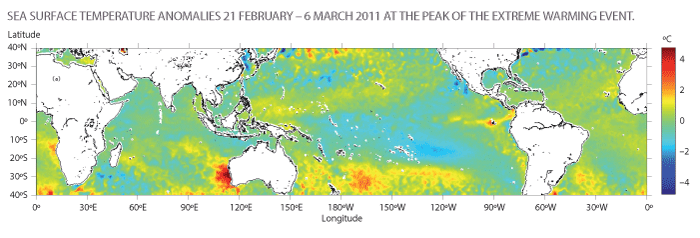
By Melissa Marino
The events that conspired to create the deadly marine heatwave – the ‘Ningaloo Niño’ of 2010-11 – can be traced all the way to Alaska.
Ming Feng is the CSIRO Wealth from Oceans Flagship scientist whose research inspired the term ‘Ningaloo Niño’, referencing the specific Western Australian phenomenon.
He says that a long-term trend in the Pacific Ocean that affects fisheries as far north as Canada and Alaska set the scene for the events that led to the extreme sea temperatures recorded off the Western Australian coast in 2011. This trend, known as the Pacific Decadal Oscillation (PDO), was identified by North American fisheries scientists in the 1990s. It refers to the warming or cooling of surface waters in the northern realm of the Pacific Ocean, which affects salmon production regimes.
In the PDO’s current cool phase, more heat builds in the western Pacific Ocean, the Indonesian seas and waters off north-west Australia. There is also a greater likelihood of La Niña events, in which sea surface temperatures north of Australia are often warmer than normal.
The summer of 2010-11 witnessed the second strongest La Niña of the past century, sweeping a body of warmer water through Indonesia on fierce easterly winds and driving it down the WA coast on an unseasonably strong Leeuwin Current.
The Leeuwin Current is a warm ocean current that flows southward all year, bringing tropical water with it. Usually it runs strongest in autumn but in the summer of 2010-11 it surged due to the strong La Niña associated with the PDO. Ming Feng says the La Niña also drove a pressure system off the coast, which caused a southward wind anomaly to further enhance the strength of the current.
These events also helped create an on-land heatwave that saw no real sea breeze and a long run of days of more than 40°C; the hot, still air lying over the ocean further increased the sea temperature.
“The combination of remote and local wind forces caused the warming event in February and March 2011, where the temperature was almost 3°C higher than normal, centred around Shark Bay and the Abrolhos Islands,” Ming Feng says. “This was more than double the previous recorded temperature increase set in 2000 in line with another La Niña event.”
The water temperature peaked during a two-week period at 28°C, up from the usual 23°C. It was so high it was underestimated by the numerical models and surprised the marine community.
“We have seen what I would call ‘normal’ temperature fluctuations according to El Niño or La Niña events but these kinds of temperature extremes we have probably never seen here before,” he says.
In the two years since the heatwave, sea temperatures have remained high at 1°C to 2°C above average. In 2011-12 this was attributed to another, weaker La Niña event, but in the most recent summer in which there was no La Niña, the higher temperatures were probably linked to the continued cool phase of the PDO, according to Ming Feng.
He says WA fishers and fisheries managers should get accustomed to operating in warmer waters as higher ocean temperatures are expected to become the norm, with an increase of 1°C to 2°C in 50 years. This is despite indications that the Leeuwin Current will weaken in that time. “In 50 years’ time we will see these higher temperatures as normal,” he says.
In the meantime there will be year-to-year temperature fluctuations and the possibility of another extreme event such as the Ningaloo Niño cannot be ruled out, he says, particularly while the PDO remains in a cool phase. Intergovernmental Panel on Climate Change scientists are working on models to better predict the duration of PDO phases, he says.
While present climate models can predict the likelihood of a La Niña or El Niño event about one to three seasons in advance, models would need to improve to predict such extremes as were witnessed in 2010-11, he says. Ming Feng and other oceanographers are continuing to work with the Department of Fisheries WA to optimise communication of climate information with stakeholders.
The FRDC is also funding research with collaborators from CSIRO and the Department of Fisheries WA on the projected impact of climate change on WA fisheries. Ultimately, climate information will help fisheries managers design optimal fishery management plans, he says.
See also:
Climate changes put heat on fisheries
Devastation in Shark Bay nipped by diversification
FRDC Research Code: 2010-535
More information
Ming Feng, 08 9333 6512
ming.feng@csiro.au





